Cleaning up after hoarding isn’t just about tossing junk into a dumpster. It’s about restoring a home—and helping someone take back their life. That’s why this job requires more than a broom and a couple of trash bags.
At Bio-One, we’ve seen firsthand what hoarding really means. We know it’s not just a mess. It’s emotional. It’s complicated. And it often hides some very real dangers.
Here’s why hiring Bio-One is the right call—and why everyday cleaning crews and junk removal services just aren’t enough.
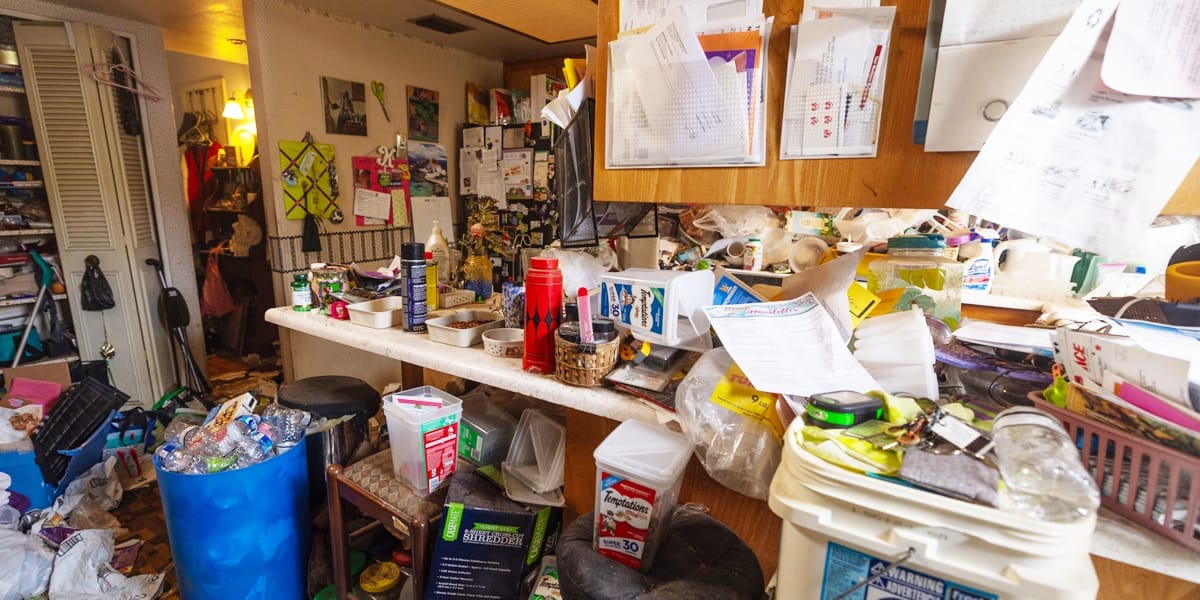
Every successful hoarding cleanup starts with one thing: a plan. But not just any plan—a personalized, compassionate roadmap designed around your unique situation.
At Bio-One, we don’t just show up with trash bags and gloves. We take the time to understand the home, the person, and the emotional weight behind it all.
Here’s how our thoughtful, professional approach sets us apart:
Trying to tackle a hoarding situation without a plan is like trying to fix a house without blueprints. A junk removal service may clear things out, but it won’t solve the deeper problems. We will.
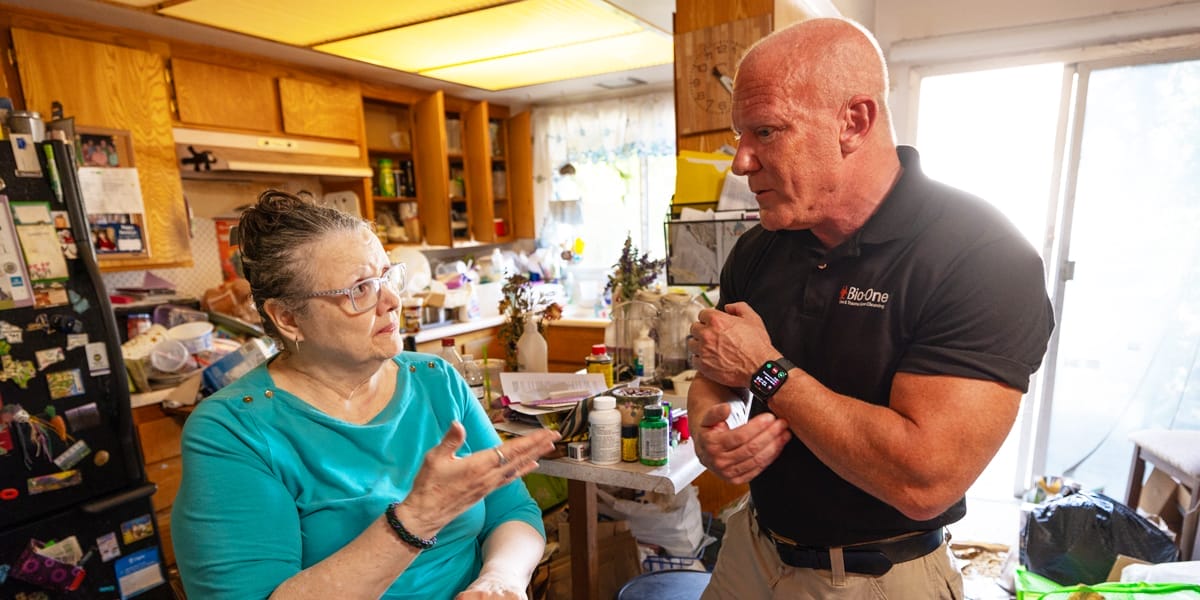
Clearing a hoarded home isn’t just time-consuming—it’s physically exhausting. What appears to be a few rooms of clutter can quickly become a grueling, multi-day challenge. This isn’t your average “spring cleaning.”
Here’s what you’re really up against:
What’s manageable in the beginning can become overwhelming fast. Even seasoned cleaning crews often underestimate the time required for hoarding cleanup and the demands it poses once the work begins.
At Bio-One, we come fully equipped with the tools, protective gear, and trained professionals to power through the most intense labor. We pace the work strategically, protect everyone’s safety, and make real progress without cutting corners.
This isn’t just about strength—it’s about stamina, strategy, and knowing how to get the job done right.
Behind the piles, underneath the clutter, and deep within hoarded homes, dangerous contaminants are often quietly festering. These aren’t just cleaning challenges—they’re serious health threats.
Most people think hoarding is just a matter of a mess. But in reality, it’s often a biohazard scene waiting to be discovered.
Here’s what might be lurking just out of sight:
All of these are considered biohazards—and they’re not something an average junk removal crew or cleaning company is trained (or legally allowed) to handle.
At Bio-One, we’re certified to clean, disinfect, and properly dispose of hazardous materials. Our teams follow OSHA standards, use full protective equipment, and know how to handle even the most extreme situations with professionalism and care.
This isn’t a job for amateurs. If biohazards are involved—and they often are—you need a team that knows what they’re doing and has the certifications to prove it.
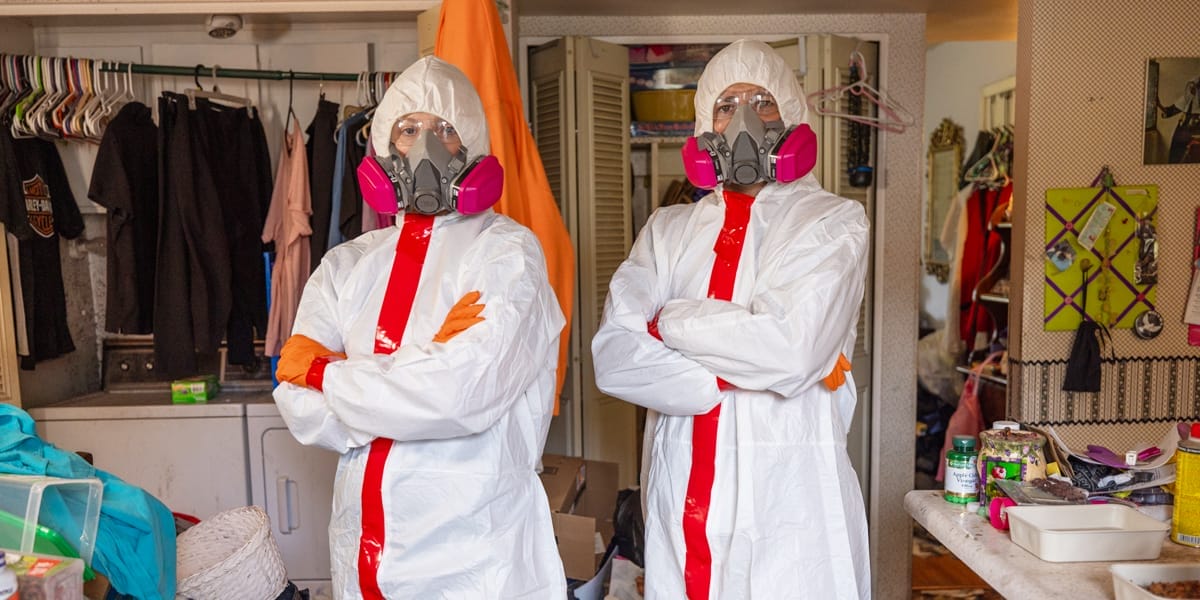
When a home becomes overwhelmed by clutter, it doesn’t just feel uncomfortable—it becomes the perfect environment for pests and rodents to move in and multiply.
All it takes is a little food waste, some moisture, and a few dark hiding places—and suddenly you’re dealing with an infestation that’s hidden in the walls, under furniture, and deep within the piles.
Here’s what’s commonly found in hoarded environments:
These pests don’t just damage property—they carry diseases like salmonella, leptospirosis, and hantavirus. Their waste can become airborne, and their presence can quickly spiral into a full-blown health crisis.
The truth? Pest problems in hoarded homes are rarely just a matter of extermination. Once pests have contaminated the environment, specialized cleaning is required to safely remove all traces and restore the space to a livable condition.
At Bio-One, we don’t just deal with the aftermath—we know how to spot the signs of infestation early, contain the spread, and safely remove biohazards left behind. We work discreetly, using professional-grade equipment and proper safety gear, so you don’t have to risk your health or well-being.
In a hoarded home, mold is more than just a patch of discoloration—it’s a growing, hidden danger that’s often overlooked until it becomes a serious health risk.
With so much clutter packed into every corner, proper airflow is restricted. That means moisture lingers, leaks go unnoticed, and humidity builds up. And mold? It thrives in those exact conditions.
Here’s why mold is such a serious concern in hoarding situations:
Cleaning up visible mold is one thing. However, in hoarded homes, mold is rarely limited to the surface. It’s often embedded deep in the environment, and removing it safely requires proper containment, specialized PPE, and professional remediation tools.
At Bio-One, we’re trained to detect, isolate, and eliminate mold as part of our hoarding cleanup process. We know where to look, how to test, and when it’s time to bring in mold remediation protocols. We also take steps to prevent regrowth, helping restore a safe and breathable living space.
When most people think of hoarding, they picture stacks of newspapers, rooms overflowing with clutter, and hallways cluttered with items. What they don’t picture—but absolutely should—is the invisible cloud of contaminated air hovering over it all.
Poor air quality is one of the most hazardous and least understood risks associated with hoarding cleanup. Every time you move a box, lift a rug, or shift a pile, you release pollutants that have been building up for years, sometimes decades.
Here’s what gets stirred into the air during a hoarding cleanup:
Prolonged exposure to this mix can lead to headaches, respiratory infections, asthma flare-ups, dizziness, and even long-term lung damage. For people with allergies, pre-existing conditions, or weakened immune systems, it can be dangerous or even life-threatening.
That’s why Bio-One technicians wear full protective gear on every job—including biohazard suits, respirators, eye protection, and gloves. We don’t just clean—we do it safely, both for ourselves and for everyone who will re-enter the space.
We also utilize professional-grade air scrubbers, HEPA vacuums, and deodorizers to enhance the air quality as we work actively, because it’s not truly clean until it’s safe to breathe.
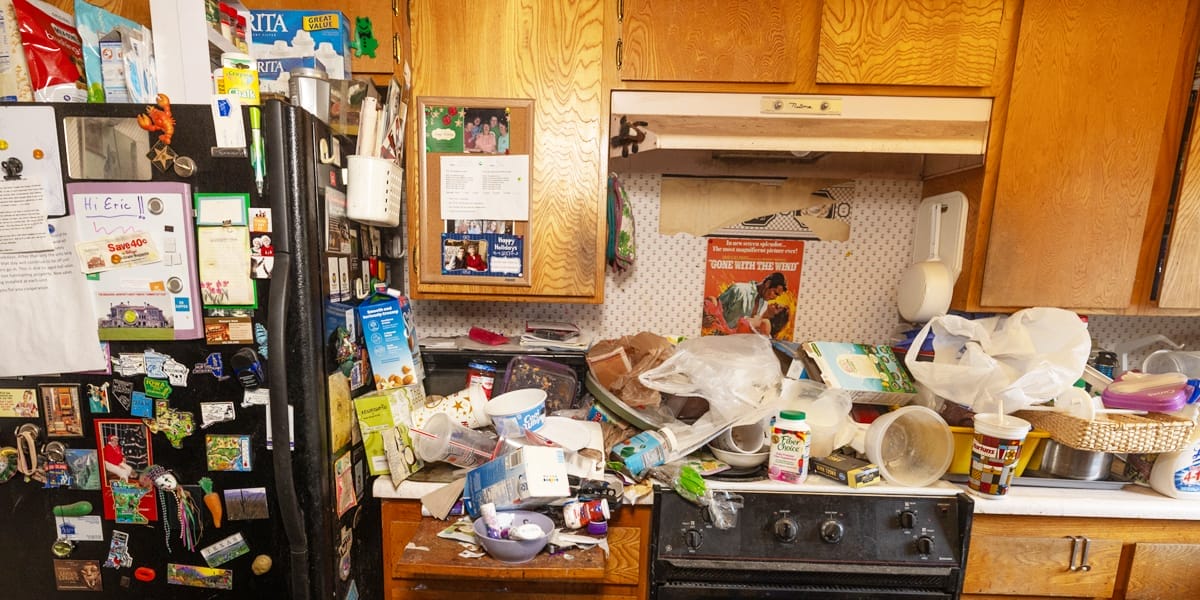
Behind every cluttered room and overstuffed hallway is a risk most people don’t consider—getting seriously injured while trying to help. Hoarding environments aren’t just hard to navigate; they’re physically dangerous, especially for anyone without the right training, equipment, or experience.
We’ve seen it happen far too often: someone with the best intentions enters a hoarded space to begin cleaning, only to walk away with a serious injury or a trip to the emergency room.
Here’s what makes these environments so hazardous:
In extreme cases, these conditions can lead to fractures, sprains, head injuries, or worse. The danger isn’t always visible, and one wrong move can lead to lasting consequences.
At Bio-One, we take safety seriously. Every cleanup is performed with full protective gear, including hard hats, puncture-resistant gloves, steel-toe boots, and back support. We use the right tools, move strategically, and always work as a team to ensure safe progress.
Your heart may be in the right place—but your body could pay the price if you go it alone. Let the professionals handle the heavy lifting—literally.
When a home is filled with clutter, the fire risks don’t just increase—they multiply exponentially. From stacks of flammable materials to blocked exits and overloaded electrical outlets, hoarded homes can become fire traps waiting for a single spark.
What makes hoarding situations so dangerous during a fire?
The result? Fires in hoarded homes spread faster, burn hotter, and are far more deadly.
At Bio-One, we don’t just clean up clutter—we help prevent tragedy. By restoring open pathways, removing excess materials, and identifying key fire hazards during the cleanup process, we dramatically reduce the risk of fire and create a safer space for everyone.
If someone you love is living in a hoarded environment, acting now could save a life later. A clear space is a safe space—and we’re here to help make that happen.
It’s easy to focus on the visible mess in a hoarded home, but what’s happening beneath the clutter can be even more dangerous. Years of neglected maintenance, trapped moisture, and excessive weight from accumulated belongings can cause severe structural damage that’s often hidden until it’s too late.
These aren’t just cosmetic issues. They pose safety hazards that can compromise the integrity of the entire home.
Here’s what we frequently encounter during hoarding cleanups:
In some homes, the damage is so severe that certain areas become unsafe to enter. Unfortunately, most junk-hauling crews won’t notice—or worse, won’t care—about these risks. They’re there to move stuff, not protect the property.
At Bio-One, we assess more than just the mess. We recognize the signs of serious structural issues and never proceed if it puts someone at risk. If needed, we’ll stop the cleanup and recommend licensed contractors or specialists to address the problems safely and correctly.
We treat every home with the same care and caution we’d want for our own. Because restoring a home doesn’t just mean clearing space—it means making sure it’s safe to live in again.
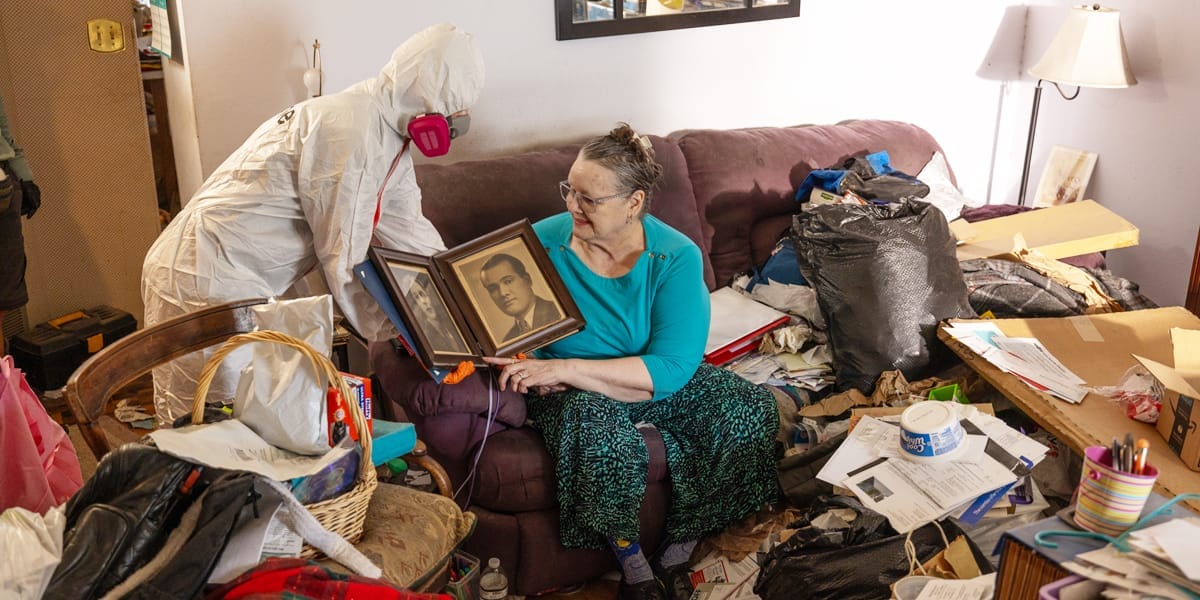
When someone you care about is struggling with hoarding, stepping in to help is the right thing to do. But without the right approach, even the best intentions can cause deep emotional pain and strain the relationship for years to come.
That’s because hoarding is rarely just about clutter. It’s about fear, trauma, grief, and loss. For the person who hoards, those piles aren’t just junk—they’re comfort, control, or connection. Having someone touch one's belongings without permission can feel like an invasion.
Here’s what we’ve seen time and time again:
That’s why Bio-One approaches every hoarding situation with more than just tools and trash bags—we bring compassion, patience, and a neutral, calming presence.
Here’s how we help preserve relationships and reduce emotional strain:
We’re not here to rush a process that takes time. We’re here to help everyone involved move forward together, with dignity, understanding, and as little conflict as possible.
Because cleaning a home is one thing, helping a family heal is something else entirely.
Hoarding isn’t just about piles of stuff. It’s about stories, struggles, and people who need help reclaiming their space—and sometimes, their life. That kind of transformation takes more than cleaning supplies and a crew with a truck. It takes compassion, patience, and a team that truly understands.
At Bio-One of Johnstown, we’re not just here to remove clutter. We’re here to restore peace of mind, rebuild safety, and offer dignity to the people at the heart of it all.
If you’re facing a hoarding situation—whether it’s your own, a loved one’s, or a client’s—you don’t have to do it alone.
Call Bio-One of Johnstown today. We’re ready to help—gently, respectfully, and without judgment. This isn’t just cleanup. It’s a clean start. And we’ll be with you every step of the way.
Bio-One specializes in hoarding cleanup, which goes far beyond surface cleaning or hauling away items. We assess safety risks, identify biohazards, and create a customized plan that considers emotional, physical, and environmental factors. We’re trained, certified, and compassionate—and we never judge.
Hoarded environments often contain hidden risks, such as mold, pests, structural damage, and biohazards (including feces, urine, and decomposing food). Attempting to clean up without proper equipment and training can lead to injury or illness. Our team utilizes protective gear and adheres to strict safety protocols to ensure the job is completed safely and thoroughly.
It depends on the size of the property and the extent of the hoarding. Some jobs can be completed in a single day, while others may take several days or longer. We’ll provide a clear timeline after our initial assessment and work at a pace that’s comfortable for you or your loved one.
Yes. We approach every situation with compassion and respect. We’re here to support—not shame—those struggling with hoarding. We listen, explain each step, and work at a pace that protects emotional well-being. Our neutral presence can also help reduce tension between family members.
We remove trash, damaged items, expired food, contaminated materials, and any other items that pose a health or safety risk. We always consult with the client about what should be kept, donated, or discarded. Valuables and sentimental items are handled with care and preserved whenever possible.
We’re trained to deal with mold, odor, and indoor air quality issues. During cleanup, we may use HEPA filters, deodorizers, and industrial-strength disinfectants to improve air quality and remove lingering odors. Mold is common in hoarded homes—and we know how to identify and safely treat it.
Yes. Rodents, roaches, flies, and other pests are common in hoarding situations. We remove nests, droppings, and contaminated items, and thoroughly clean and disinfect affected areas. If needed, we can recommend pest control partners to assist with pre- or post-cleanup services.
Absolutely. Animal hoarding creates very sensitive and hazardous conditions. Our team is experienced in handling these situations with discretion and care. We safely clean and disinfect areas affected by urine, feces, and decomposing material, while preserving as much of the home as possible.
In some cases, yes—especially if there is structural damage or biohazard contamination. We can help you navigate insurance claims and provide the necessary documentation to support the process. We’ll also clearly explain your options, including payment plans if needed.
Yes. We understand the stigma that can surround hoarding. That’s why we use unmarked vehicles (upon request) and work with complete discretion. We don’t share information, take photos without permission, or speak publicly about any job. Your privacy is always respected.
Navigating Hoarding Disorder Together: Support Strategies for Families
At Bio-One of Johnstown, we’re acquainted with the journey that brought you here. We understand you’ve already been trying to solve this problem alone—and we’re proud of you. It’s tough. You’ve been struggling out of concern for the hoarder, for you, for your family, for the property… and the list can go on.
Hoarding is complicated and messy. But you already know that.
After 20+ years of hoarding cleanup, we’ve made some observations and learned some lessons we’d like to share with you—because we feel they might help you and the hoarder.
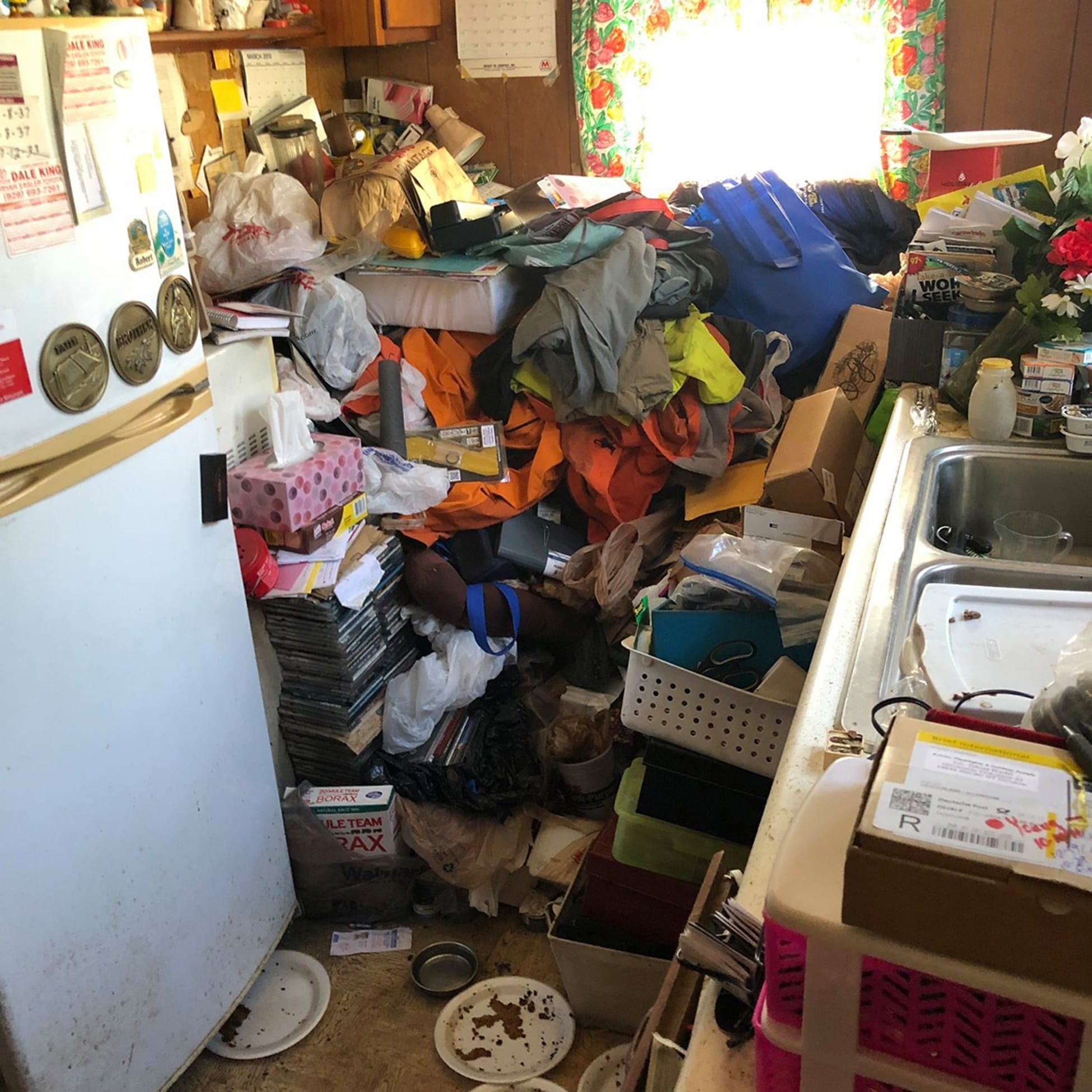
On the outside looking in, you see clutter, chaos, and conditions that are unhealthy and hazardous, such as:
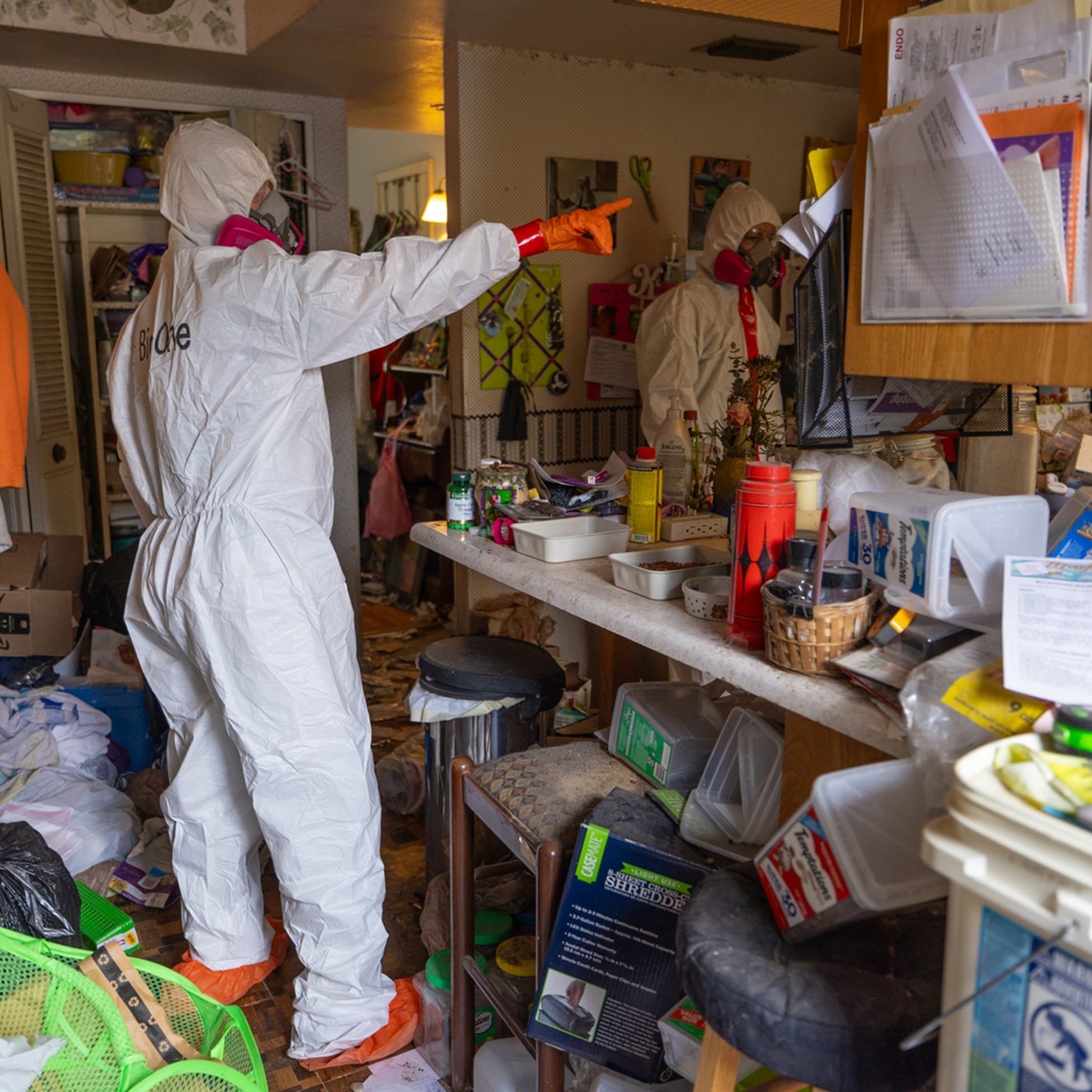
On the inside, however, you see a person—a family member—struggling and probably isn’t consciously choosing to live this way.
Hoarders hoard for various complex reasons, and the exact cause can vary from person to person. Hoarding is recognized as a mental health disorder known as "hoarding disorder."
It's essential to understand that hoarding is not just a matter of being messy or disorganized; it involves deeply ingrained thoughts, behaviors, and emotions.
Some of the primary reasons why hoarders hoard include:

When dealing with hoarding behavior, every experience of trying to help can unfold uniquely, filled with challenges and lessons.
It is not uncommon for the initial attempt to be met with resistance. Hoarding is more than just a clutter issue; it manifests deep-seated emotional, psychological, and sometimes physical struggles. Recognizing this is a crucial first step before embarking on the journey of helping a hoarder.
The journey is rarely linear. There are often setbacks where progress might seem to reverse. Stressful events or emotional lows could trigger this.
Not great, right?
When dealing with a hoarder and cleaning up their belongings, you might experience a range of complex and intense emotions.
Here are some common feelings and emotions you may go through:
It's important to acknowledge that these emotions are normal when dealing with hoarding. Consider seeking therapy or support groups to help manage these feelings and learn effective strategies for assisting your loved one in addressing the hoarding disorder.
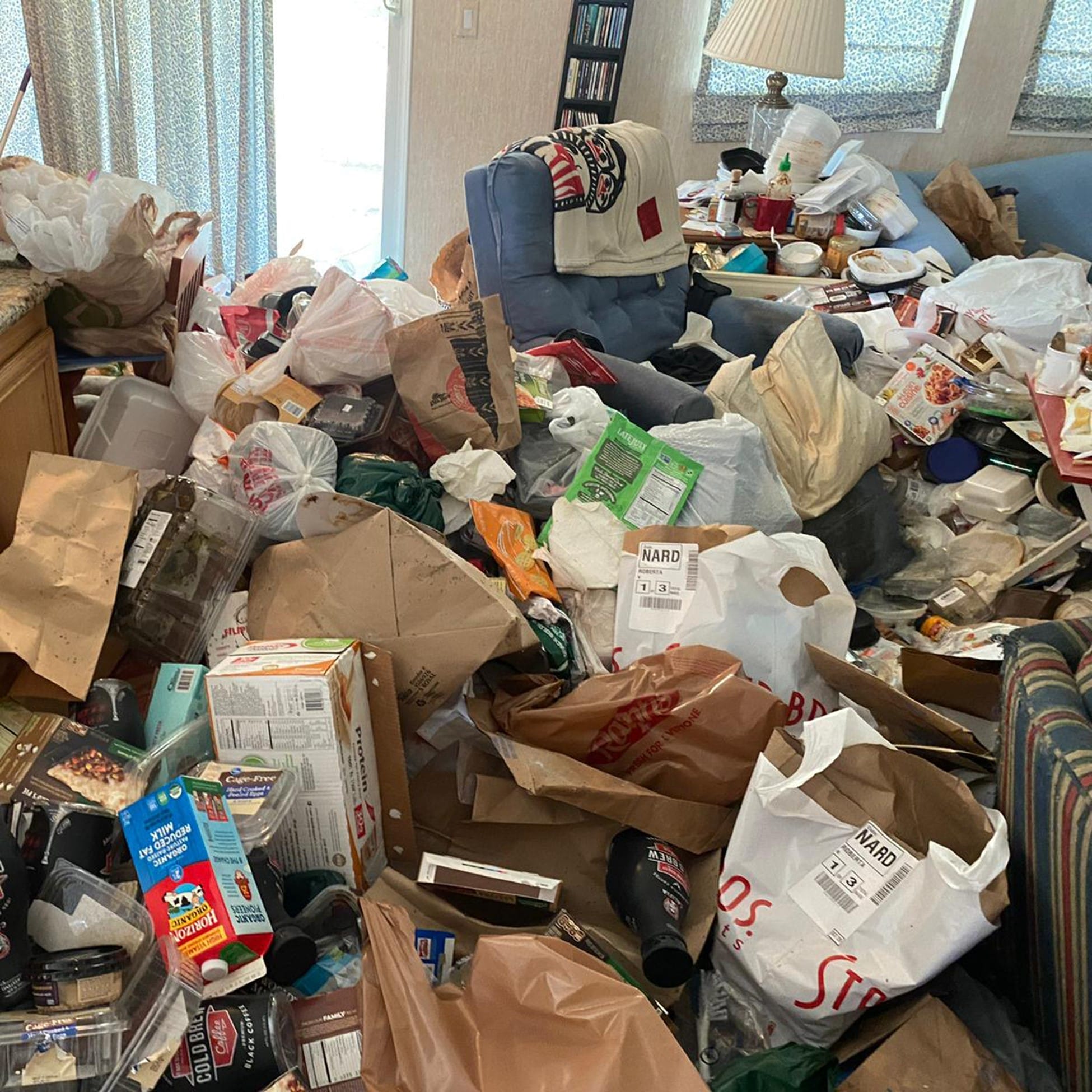
When you approached the hoarder about their hoarding, the hoarder may have experienced a wide range of emotions and reactions.
These can include:
Appraising a hoarder with empathy, understanding, and patience is essential. Hoarding disorder is a complex mental health condition, and hoarders often need professional intervention and support to address their underlying issues.
Consider involving therapists, counselors, or hoarding cleanup specialists to facilitate productive conversations and provide guidance on the path to recovery.
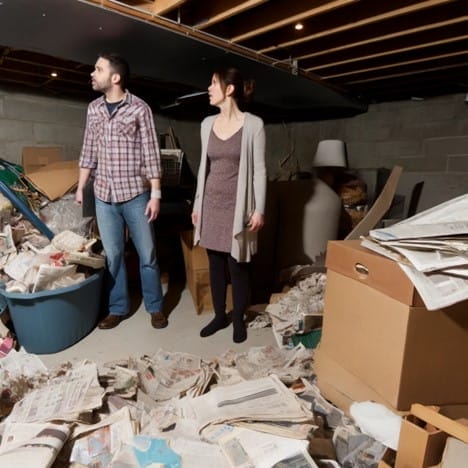
It's essential to understand how to provide support effectively. Hoarding Disorder often leads to a refusal of help, which can be frustrating for family members. To make a difference in your loved one's life, it's crucial to comprehend why they are reluctant to accept assistance.

There are no shortcuts or one-size-fits-all solutions to dealing with hoarding disorder. It's a complex issue with deep-rooted psychological factors and emotional complexities. However, as you've embarked on this journey as a concerned family member or a friend, you've already taken a significant step.
You've shown care, patience, and understanding, and that's commendable. Remember, you're not alone in this journey. There are resources, support groups, and professionals who specialize in hoarding disorder and its treatment.
At Bio-One, we've witnessed countless stories of transformation. We've seen homes go from chaos to cleanliness, and we've watched individuals recover from hoarding disorder.
The key is persistence and empathy. Understand that recovery may be slow, with ups and downs, but every small step counts. Seek professional guidance, involve therapists, and educate yourself about the condition. Your loved one needs your support more than ever.
Ultimately, remember that hoarding is not a reflection of failure but a manifestation of deeper struggles. By approaching it with compassion and determination, you can help your loved one find a path to healing and reclaim their life.
For immediate expert hoarding cleanup service, contact Bio-One of Johnstown today at (814) 242-0053. Your health and peace of mind are our top priorities. Let our professional local team help you restore your environment to a safe and clean condition.
Hoarding cleanup requires specialized training to handle the complexities safely and effectively, such as removing hazardous materials and navigating challenging environments.
Hoarding cleanup involves dealing with large volumes of items, potential hazards, and emotional challenges beyond regular cleaning.
Potential hazards include mold, pests, structural damage, sharp objects, and hazardous chemicals.
While family members may assist, professionals are better equipped with the tools and knowledge to handle hoarding situations safely.
The duration depends on the severity and size of the hoard, but professionals work efficiently to restore safety and cleanliness as quickly as possible.
Professionals aim to conduct the cleanup process respectfully and compassionately, working closely with the homeowner to make informed decisions.
Skilled teams follow strict protocols to safely identify, handle, and dispose of hazardous materials in compliance with regulations.
They often undergo specialized training in handling hazardous materials, biohazards, and cluttered environments to ensure safe and effective cleanup.
Legal issues regarding property rights and safety regulations can arise, so it's vital to consult professionals familiar with them.
A: Approach the situation empathetically and encourage them to seek professional help to assist with the cleanup and any underlying issues.

The word “hoarding” probably evokes a particular image, made more common by shows like Hoarders that highlight extreme examples. In reality, not all hoarders have rooms full of items piled high to the ceiling.
The Institute for Challenging Disorganization (now, there’s a relatable title!) has classified hoarding behavior into five levels on their Clutter-Hoarding Scale.Level 1 Hoarding

At Level 1, a home is not pristine, but the space is still easily accessible and sanitary. There is clutter, but no concern for safety. Most, if not all of us, have been in Level 1. Many people spend most of their time in this stage.
Here are the defining characteristics of this level:
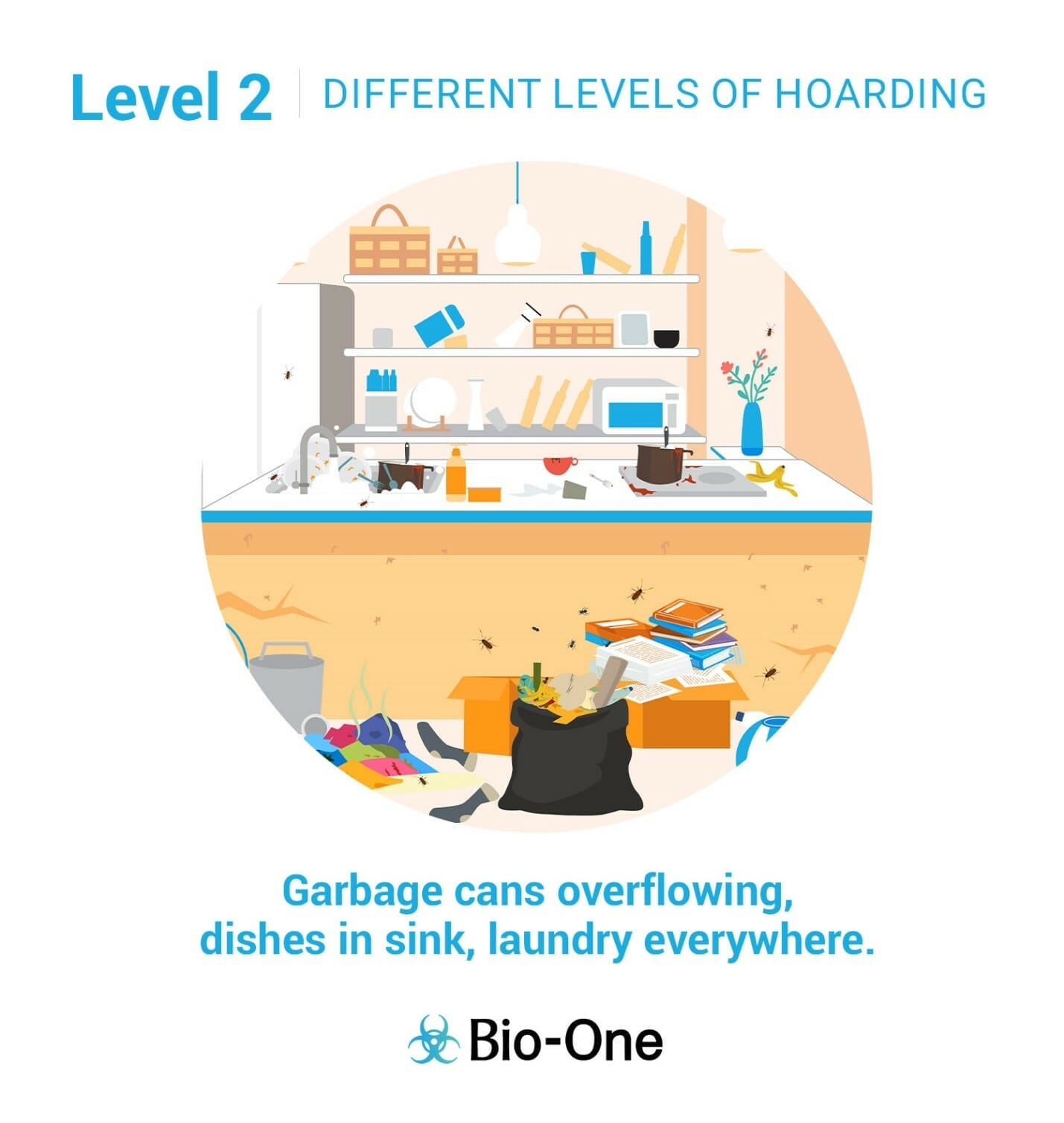
At Level 2, the home is still very livable, but there’s more evidence of disarray. The home is in need of cleaning and may be starting to overwhelm the residents. The hygiene level isn’t optimal.
Most of us bounce between Level 1 and Level 2. However, here are the more defining characteristics of Level 2:
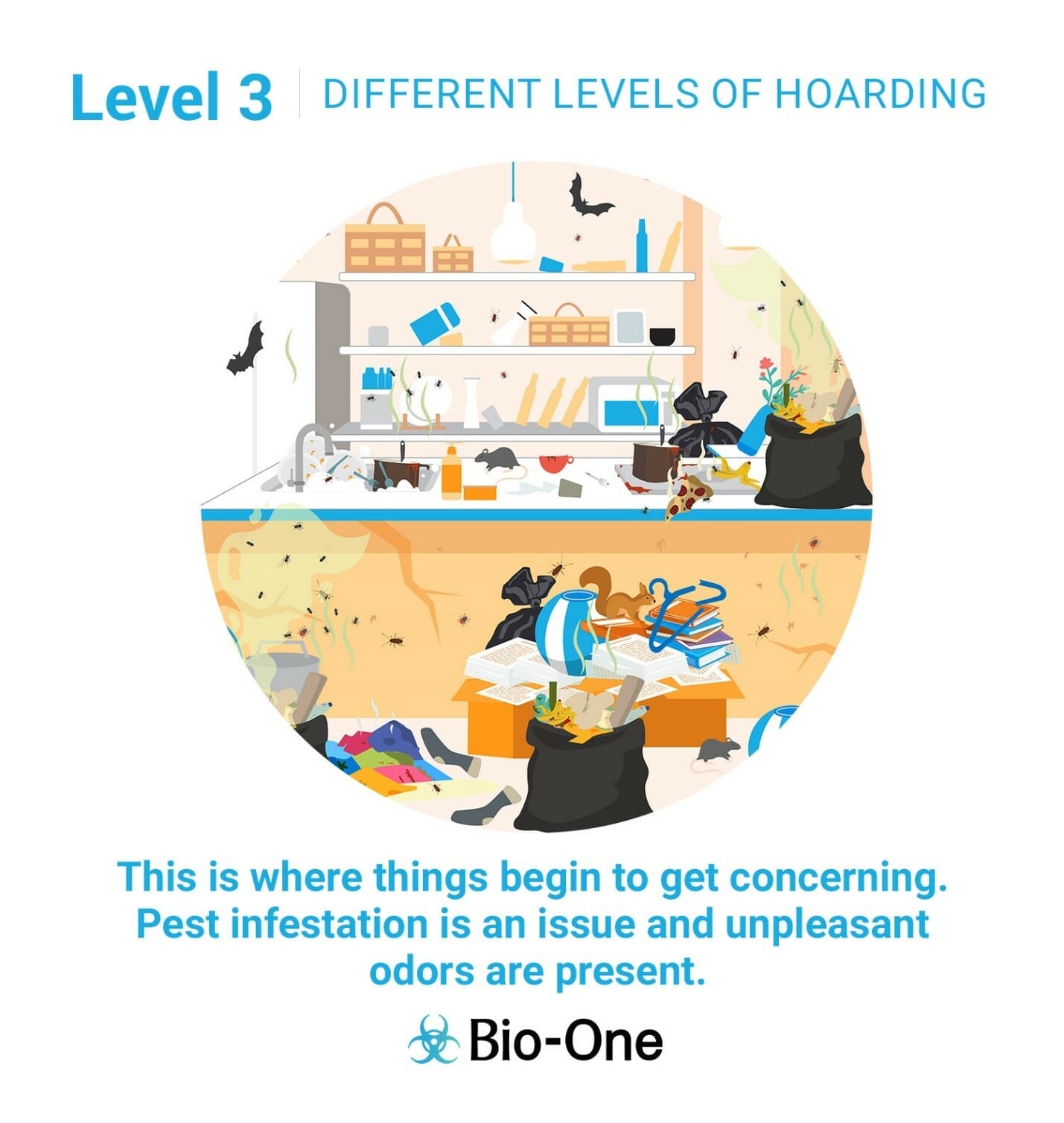
Level 3 is considered the turning point between manageable household disorganization and a more serious issue. Level 3 homes show extreme disorganization and indicate hoarding behavior.
Here are the defining characteristics of this level:
Level 3 households should consider hiring outside help. Although, it’s still possible to get it under control with a concerted effort from the whole family
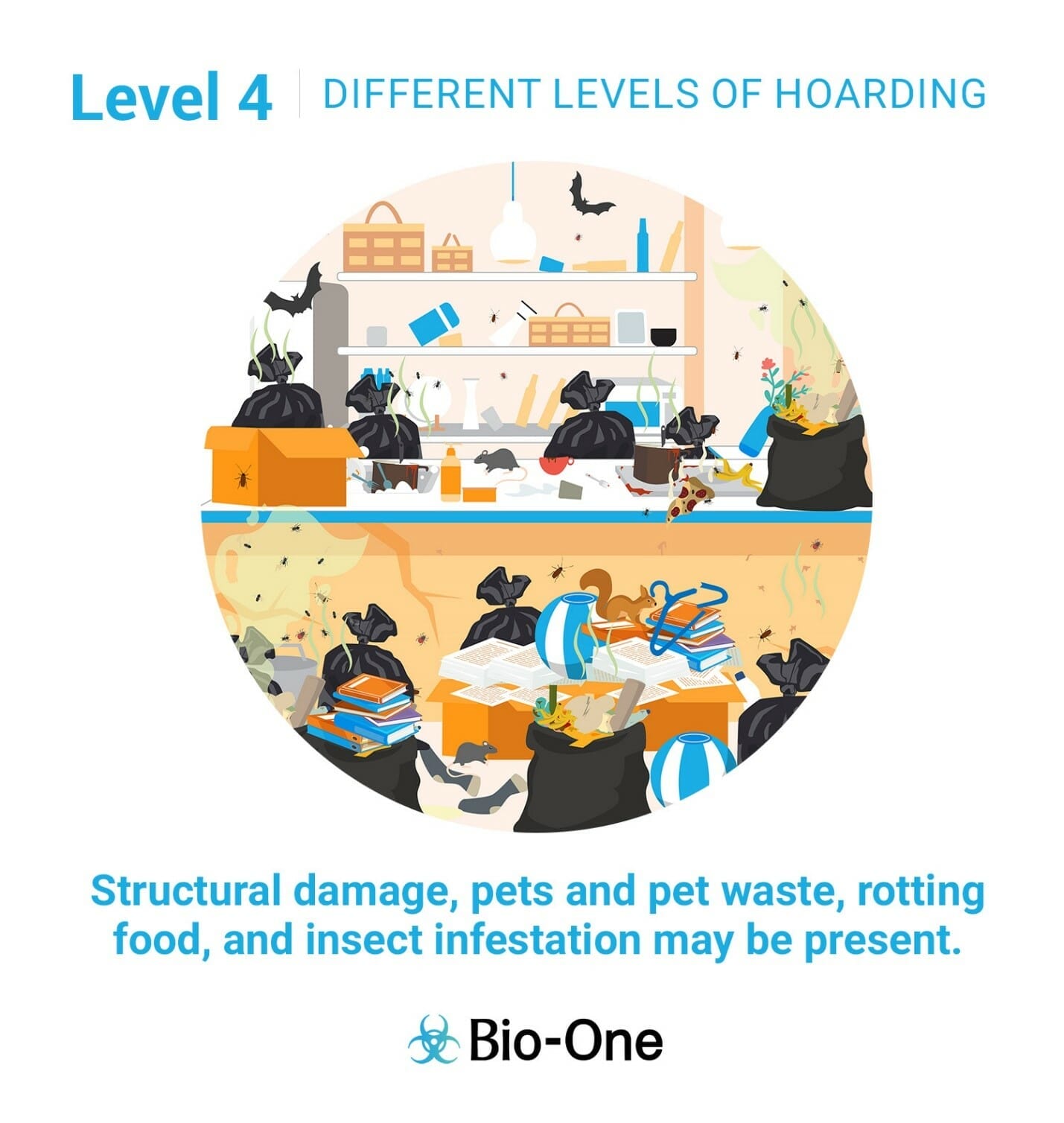
At Level 4, the home shows excessive clutter.Those living in Level 4 conditions need professional help. At this level, part of getting help includes professional cleaning to transform the house into a safe, hygienic space where people can thrive. Mental health counselors and social workers may also step in to help residents change their habits.
Here are the defining characteristics of this level:
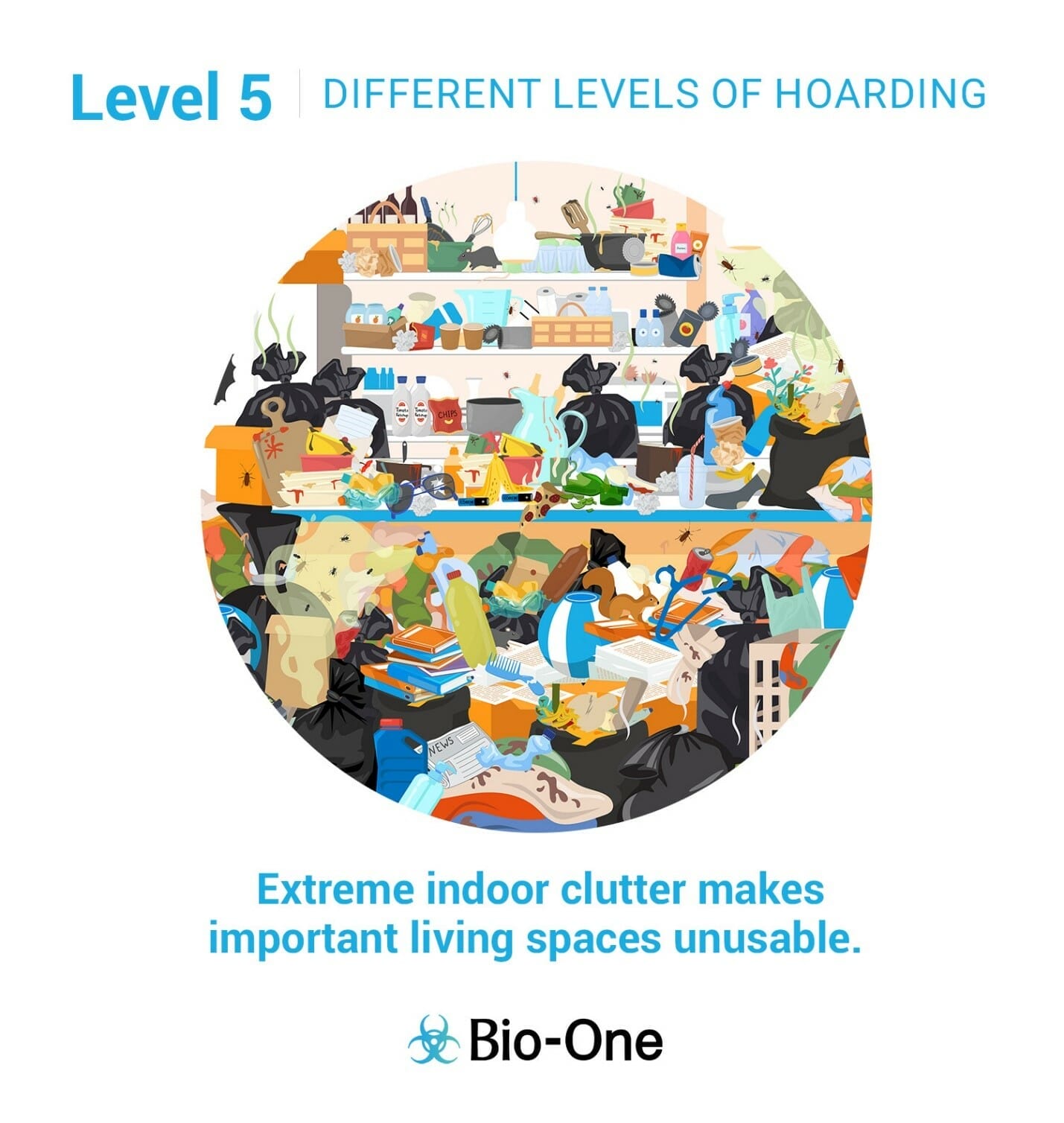
Level 5 is the highest level of hoarding behavior. Level 5 homes are alarmingly hazardous.
They require professionals with safety equipment and training to clean.
Here are the defining characteristics of this level:
If you or someone you know is struggling with these levels of hoarding we are here to help.
You can find more information at https://bioonejohnstown.com/ or contact us at (814) 242-0053
Clutter is an everyday occurrence and there comes a point when we all need to clean up our messes. Leave things long enough, and we all start to fall into one of the 5 levels of hoarding.
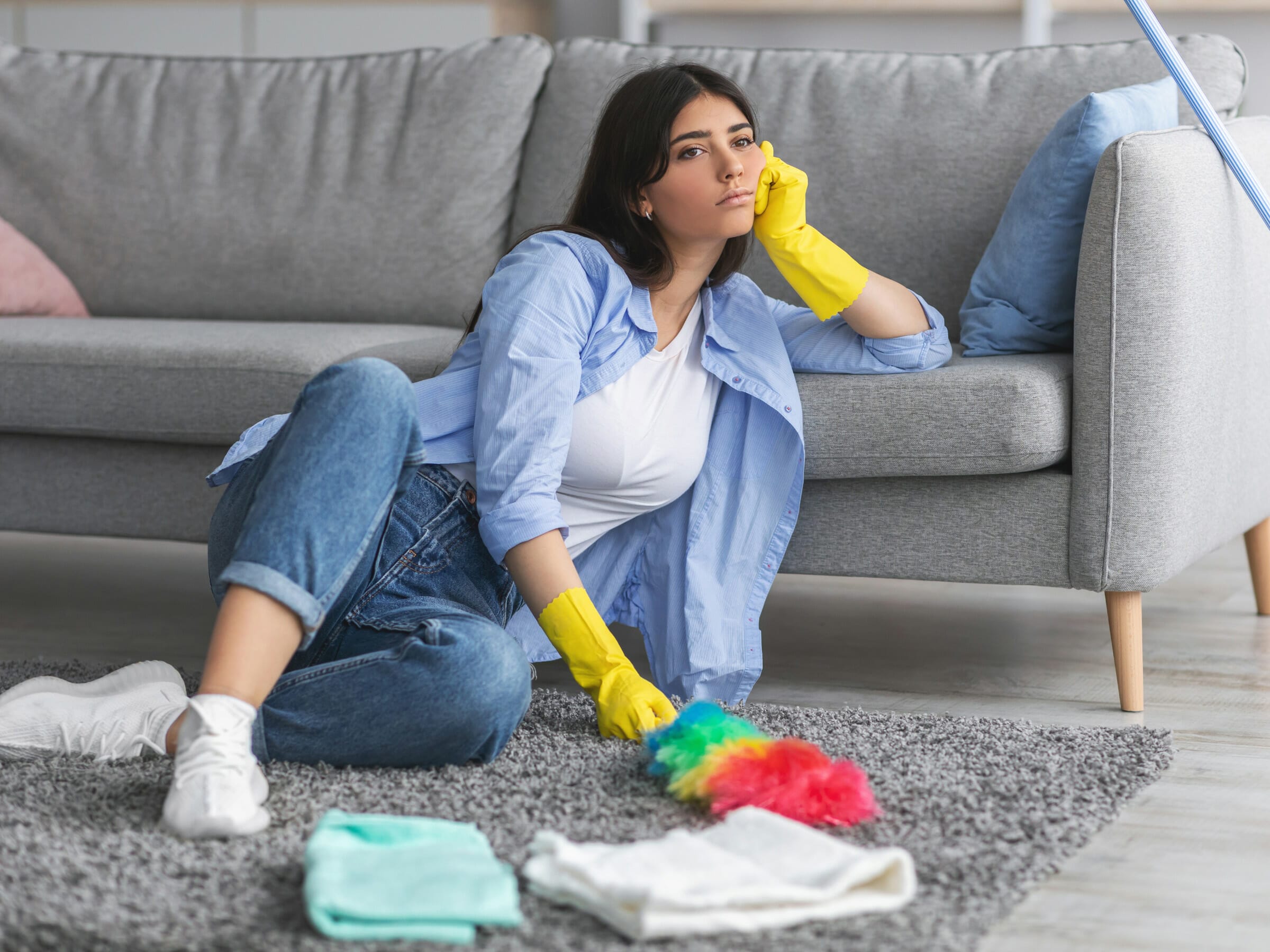
But what are the 5 levels of hoarding?
What moves a messy room from Level 2 to Level 3?
Understanding the hoarding level of your space can help you prioritize which messes are one-person tasks and which may need some help from a back-up team.
Let’s walk through each level of the Institute for Challenging Disorganization’s Clutter-Hoarding Scale to better understand just how normal hoarding is.
There’s no doubt that many of us would like our homes to look as pristine as a real estate listing ad. But life’s hectic! With busy work and family schedules, numerous responsibilities and obligations, and competing priorities it’s easy to put off a small mess for later. However those moments of procrastination stack up to put our home at a Level 1.
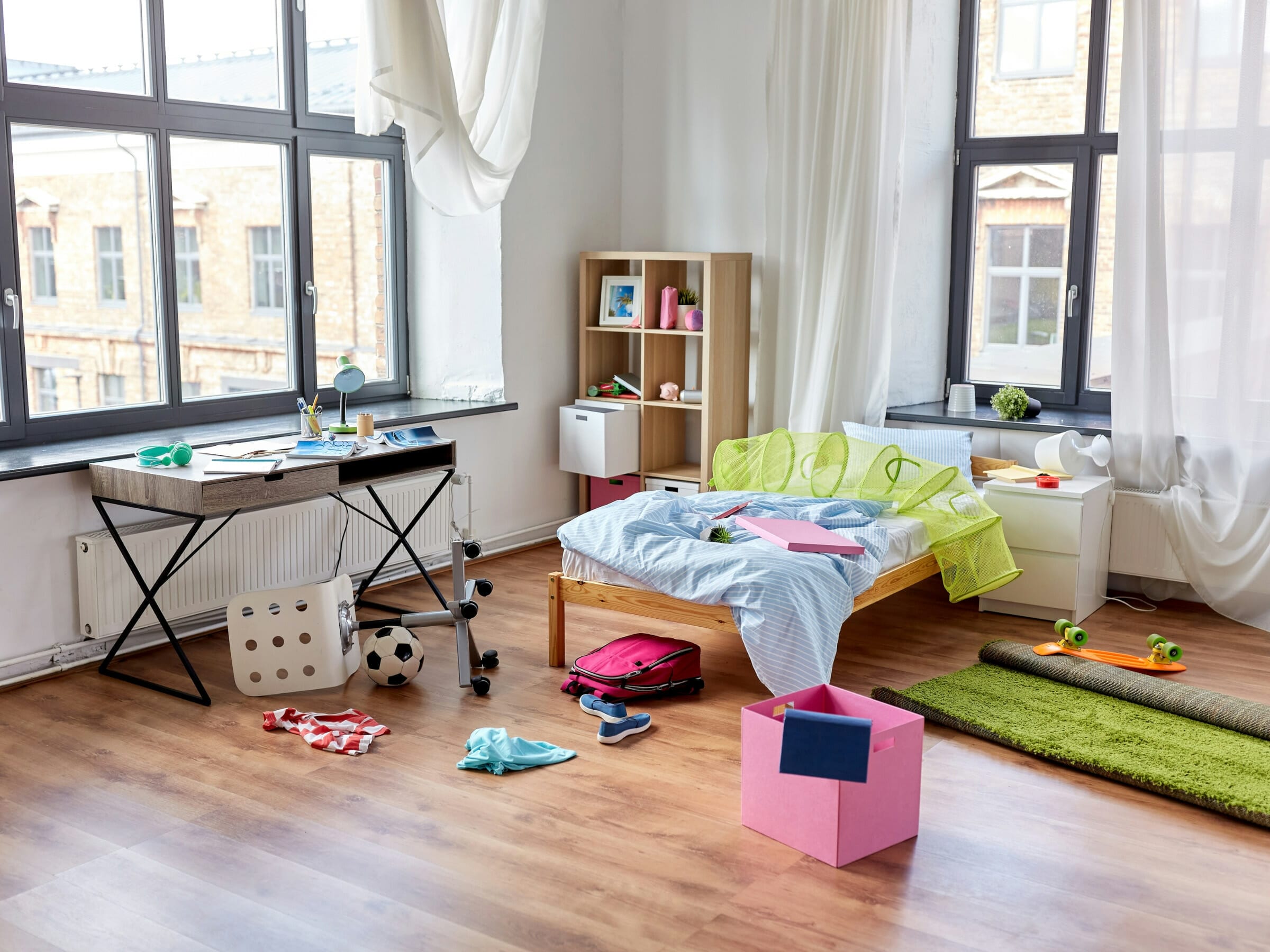
Signs of this level of hoarding include clutter and messes that do not threaten your safety:
Ok, that last one MIGHT be dangerous if you’re barefoot.
None of these messes block exits in your home, and they do not cause an immediate bad odor. If we’re honest, we can admit that all of us—at one point or another—have had our home come in on this level of the hoarding scale.
Leaving your house in this state does not necessarily affect your health.
However, it may exacerbate avoidance habits that lead to snacking and more procrastination—which might lead to more clutter, shifting you up the scale.
This is another common level of hoarding. Most of us frequently bounce between Level 1’s clutter and Level 2’s disarray.
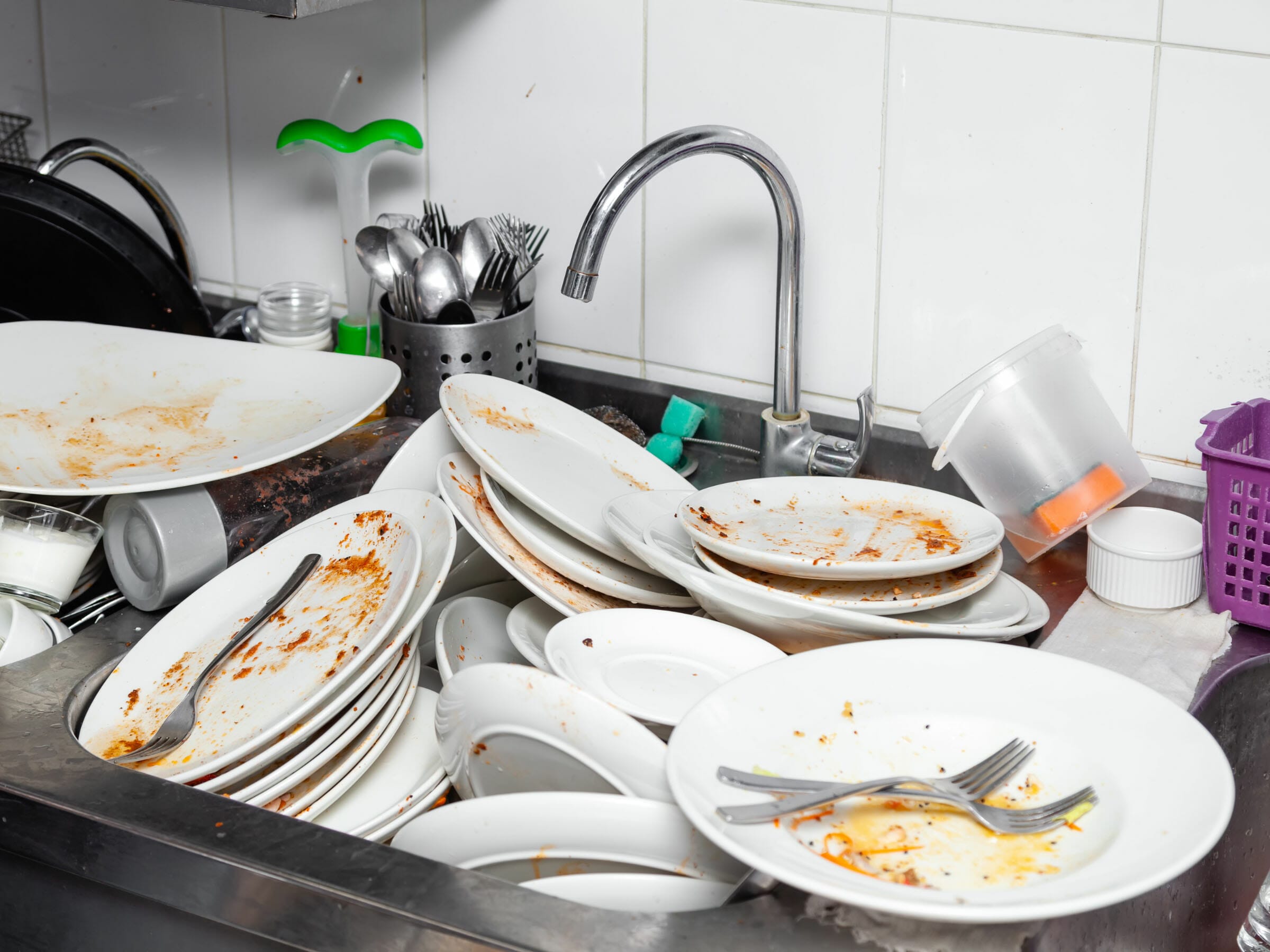
At this level, things literally begin to stack up:
At Level 2, the clutter can begin to impact a variety of areas of our lives. Some studies claim intense clutter increases our stress, makes allergies worse, and overall causes us to feel less satisfied with life.
These negative impacts are sometimes the trigger that leads to the situation getting worse.
Level 3 is where things begin to get concerning.
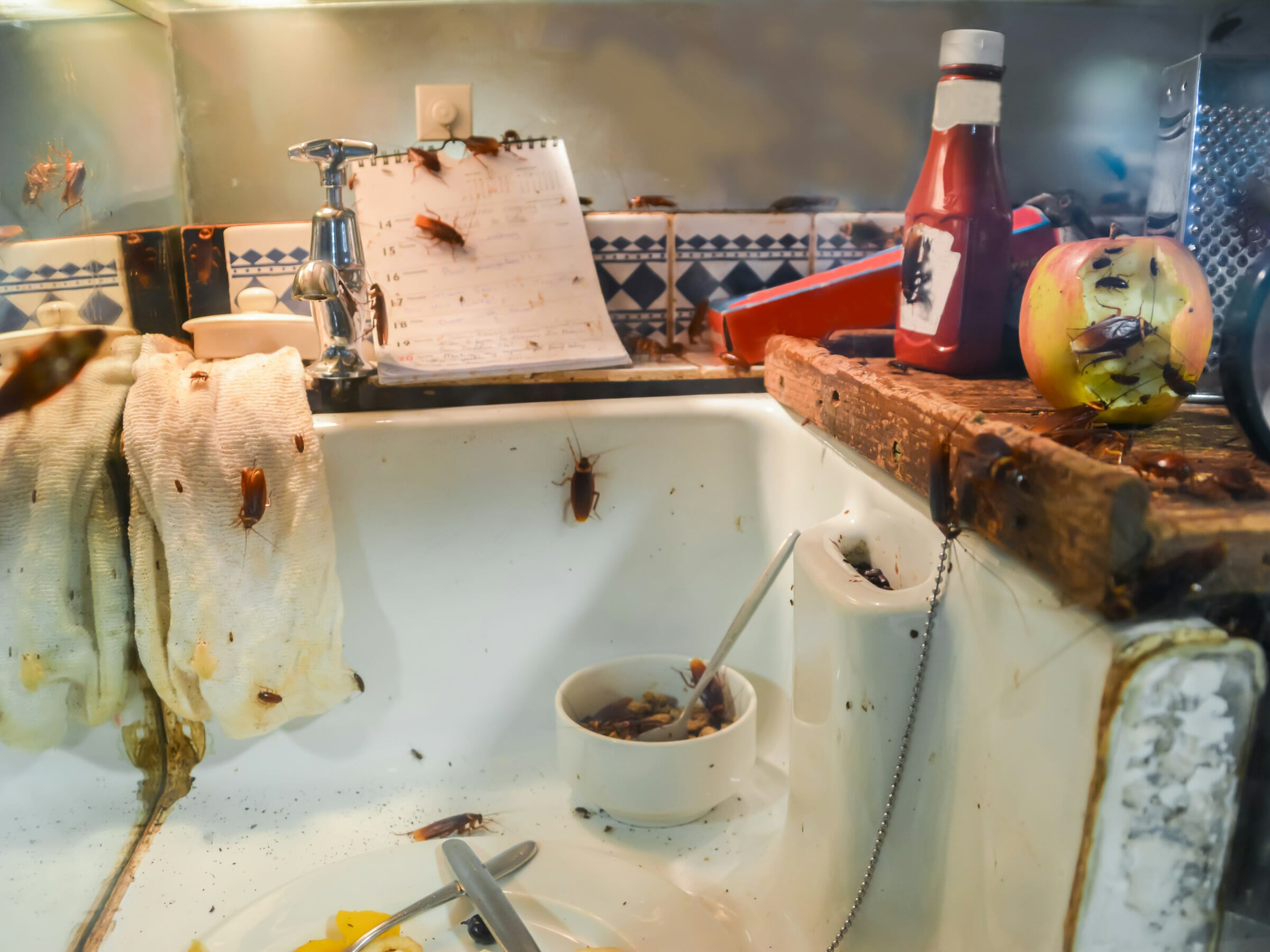
At this point, the mess itself may seem too daunting to tackle, and the increase in clutter results in a decline of cleanliness. There may be piles of objects obstructing multiple exits—or even a whole room used for storage instead of living.
It’s at this stage that pest infestations may become an issue. With the clutter, there are lots of places for unwelcome pests to hide and find food, and infestations of ants, lice, and cockroaches may warrant an exterminator. However, all that clutter makes it difficult for the exterminator to do a good job. Unfortunately, failing to clean up the source may set the stage for another infestation within a few weeks.
Another area of concern may be repairs needed around the home. Work may need to be done, but technicians or repair personnel may not be able to physically get to whatever needs to be fixed. This means small problems may become large ones as minor repairs are left to turn into bigger problems.
This state of things deeply impacts your ability to socialize. Messy and infested living spaces make it difficult to relax with your partner or family. Friends may prefer to outright avoid hangouts at your home. Your loved ones may be concerned about your living situation at this point.
The longer your home sits at Level 3, the higher the chance that leftover messes become long-term damage.
Hygiene and safety take a backseat in a house at Level 4. Long-term spills and messes create bad smells, and much of the house cannot be adequately used for each room’s purpose.
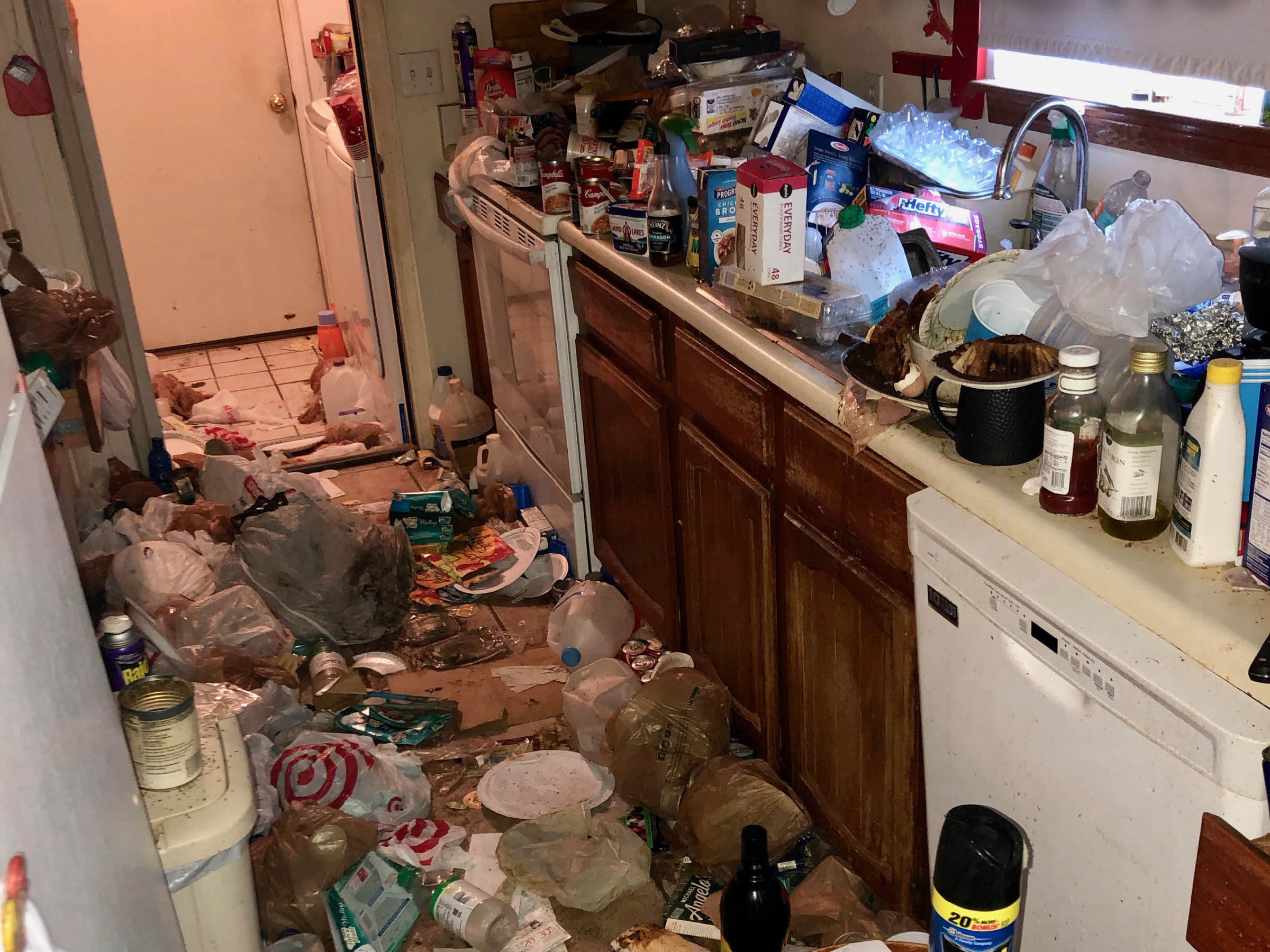
Those whose homes fit this category face daily irritation and inconvenience, all of it eventually leading to high repair bills, tripping hazards, and health hazards.
You may not think tripping hazards are a big deal, but falling over them certainly can be. Depending on how high the stacks are, they could even fall on you and do some damage that way.
There have been well documented cases where people have become trapped in their own home due to tripping hazards. Don’t let that be you!
Health hazards stack up in level 4 almost as quick as the clutter does. Issues like water damage that can no longer be reached lead to structural decay. Larger pests like bats or rodents may make their nests in the attic or basement and contribute to higher possibilities of disease.
A person or family living in this state may find it difficult to be comfortable doing anything.
Tackling the job to get the home back to a healthy and safe state may seem impossible on their own.
This is often what people think of when discussing hoarding behaviors. The situation may be the result of a psychological hoarding disorder or difficulty due to disability. It may have been compounded by depression or generational trauma or habits. The contributing factors are nuanced, varied, and often highly personal.

But whatever the reason, a Level 5 household is in need of serious, professional help.
Those in a Level 5 house live in outright unsafe conditions. On the daily they are coming in contact with:
Not only is it difficult to socialize with others in your home, you may find it difficult to even leave because of the sheer volume of things in the home and the blocked entryways.
Many who are at this stage find themselves disconnected from reality in a number of ways:
At this stage, the structural damage to the home is often irreparable and fire hazards begin to enter the picture.
Houses at level 5 are prone to fires because of the flammable piles of clutter. If a flame were to spark anywhere, it could easily catch something and spread from there.
Not only that, but it’s very difficult for firefighters to enter. If a fire were to start there’d be little to no way of stopping it. With so many flammable objects and no way to enter the home, all it can do is burn.
So how did your home do? Do you have an idea of where your home fits on the hoarding scale? The vast majority of us are on there somewhere, and the good news is that no matter the level your home scores, there is always help available.

After walking through all 5 levels of hoarding, it’s clear we all struggle with cleaning up the house sometimes. There’s nothing wrong with a messy house. It’s a part of normal, everyday life.
However, your health and safety are important, particularly when things advance to those higher levels. When facing a daunting clean-up, here’s quick tip for each level of hoarding:
Your home falls into one of these levels—just like everyone else’s! The next step is determining what you need to get back to a manageable Level 1.
Our team at Bio-One understands messy homes, and we’re here to offer discreet, compassionate help when you or a loved one is trying to dig out from a higher level mess. We offer affordable, professional services that include cleanup, disinfection, and decontamination.
Every job has a unique remediation plan tailored to the specific needs and goals of the client. Rest assured, wherever you may fall on the levels of hoarding, we have the experience and equipment necessary to help you.
Consult with our team today to discuss your situation and determine how much time you can save with professional help.
Rebecca Wallace, Bio-One owner, recently visited with Arizona Midday to share how the Bio-One team makes a difference on and off the job in Arizona and throughout the United States.
Arizona Midday - "Well we've got some help for your home right now. If you're feeling overwhelmed by a clean-up project, we've got help for you today. Rebecca Wallace is with Bio-One. Hi Rebecca. What is Bio-One?"
Rebecca - "So Bio-One is known for crime and trauma scene clean-up. However, we do a lot more than just that. We help people when there is a hoarding situation, so that they can regain their home and their lives again. We help with infectious disease decontamination, rodent droppings, odor abatement, basically if you think you might need a respirator to do the job we're the people you want to call."
Arizona Midday - "Wow, that's incredible. It's stuff we don't want to do. What made you decide to get into this line of work?"
Rebecca - "So, me and my husband live in Flagstaff most of the time and we were talking with some first responders and heard how when people pass away or they're hoarders there is no one that can help them. There's just no one who does this kind of work. So we decided we want to be able to help our community, help those around us during a time of need so they can actually move forward in their lives and not have to deal with the mess of maybe things that have happened that they don't want to have to think about."
Arizona Midday - "I love that idea. So in order to help your clients as much as possible, do you work with other companies? Tell me about that if you do."
Rebecca - "Yes, we do. We work with quite a few other companies, because what we do is just a piece of a whole puzzle. So we work with a lot of restoration companies, Best Option Restoration, they are state-wide like us so they can help us anywhere as well. We work with animal rescues, so if there is a hoarding situation that animals are involved in we can get the animals out safely and get them rehabilitated. We work with quite a few non-profits that help first responders if they're in a time of need or crisis. It's across the board. We work with all kinds of different people. Contractors. Mental health professionals. Anyone that can be a piece of that puzzle with us, we want to work with them.
Arizona Midday - "Oh, I love that. So what areas of Arizona does Bio-One cover?"
Rebecca - "We have offices all the way down from Tucson up to Flagstaff, and everything in-between. Our goal is to be able to help our clients within 90 minutes or less if there is an emergency. So we have offices everywhere. Any we're national. We have 120 offices throughout the US as well.
Arizona Midday - "Wow. That's incredible. So you work with businesses. You work with non-profits, but you're also really involved in the community too, right? Tell me about that."
Rebecca - "Yeah we are. It's important for us to give back. Our community is important. We live here. We're part of it. So in 2020 alone, we gave out over 25,000 bottles of chemicals that are approved by the EPA for COVID-19 decontamination. We have blood drives all throughout Arizona to help with the blood shortage. We donate PPE to first responders and victim advocates. And we have BBQ's throughout the state as well for all of our first responders just to tell them thank you for what they've been doing. They work hard and we want to make sure that they know we care.
Arizona Midday - "Rebecca Wallace, incredible work that you're doing with Bio-One. And thank you so much for spending time with us today.
Rebecca - "Thank you for having me."
